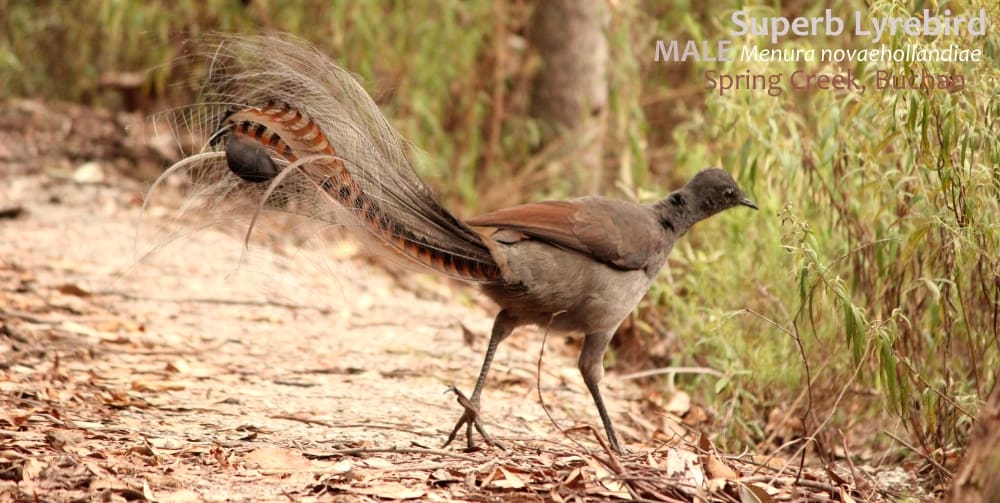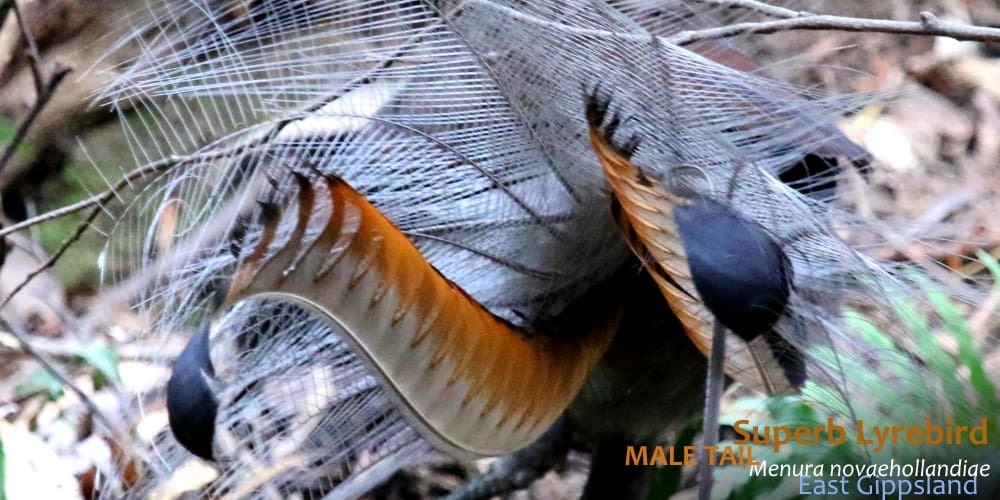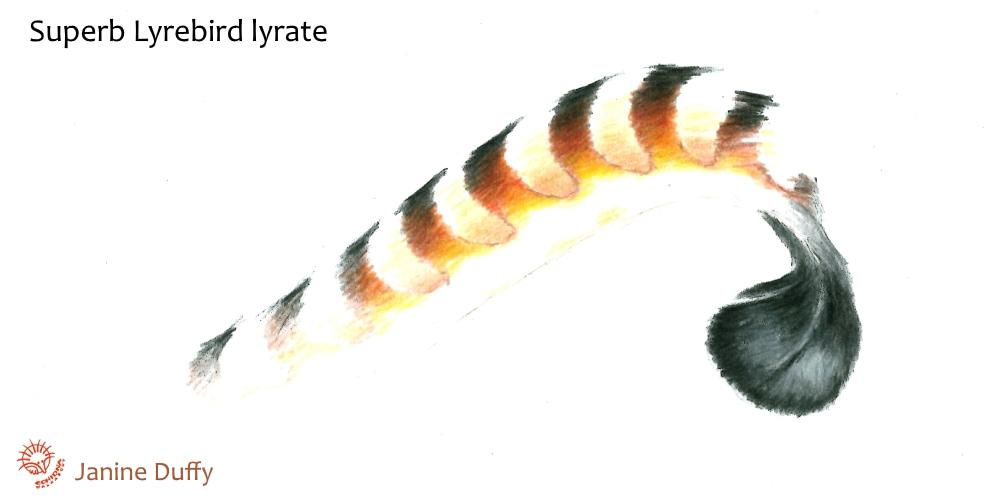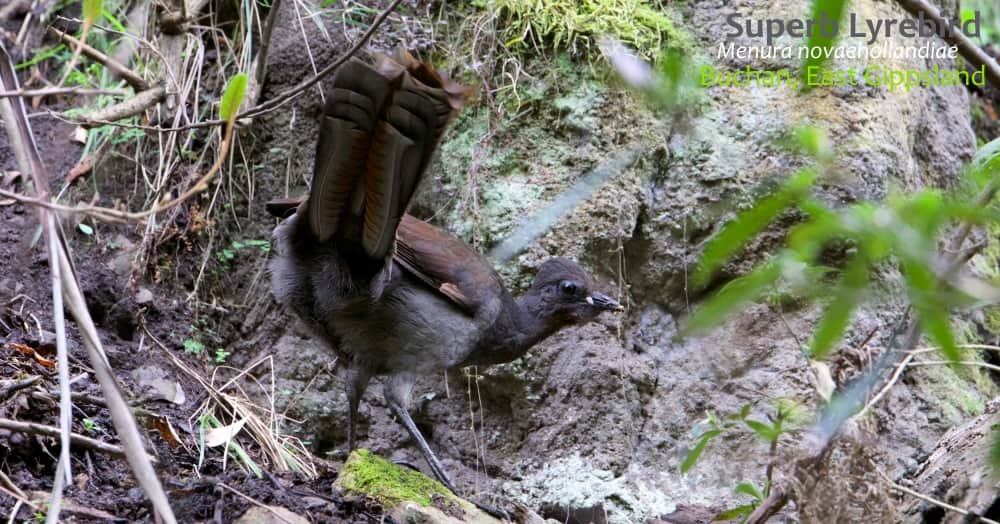Superb Lyrebirds light up the dark rainforest on winter days with their thrilling song and flashy tail.
One day in early spring I was walking with guests along a rainforest creek in the Snowy River National Park. We heard a male Superb Lyrebird singing at full strength. Quietly, we crept along the track to see him, hoping not to disturb his performance.

..
He was dancing on his mound at the base of the dry creek. All around was dark shadow, as he was, but his mound was in a patch of sun.
Flash! Our eyes were suddenly dazzled by light. What was that? A lightning strike? A bright torch?
Then we realised – the lyrebird had done it. He had suddenly flicked and vibrated his startling white tail to catch a beam of sun. The purpose of the white filamentous feathers in his plumage became clear.
In a dark rainforest, there is nothing more arresting than a beam of shimmering white light. The male lyrebird doesn’t need colour to stop the females in their tracks – he just needs light.

..
So what makes up that extraordinary lyrebird tail? And do all superb lyrebirds have that special plumage, or just the males?
Male Superb Lyrebirds (Menura novaehollandiae) have a complex plumage. Their tail comprises 2 lyrates (also known as lyres), 12* filamentous feathers and 2 median wiry feathers. The lyrates are broad, curved, banded feathers with a broad black club-like tip. The filamentous plume feathers are dark above but silvery underneath. The 2 central wiry feathers are dark.

The lyrates are stunning. Near the central vane, on the underside they are white, then grade through glossy burnt orange to black. But the feather is also barred along its length – transparent notches are spaced along the outer edge. The tip of the lyre is glossy black and rounded, and seems to hang like a bell.

It takes a male 7 to 9 years to attain this full adult plumage. Immature males at first look like females.
..
What about the females?
Adult female lyrebirds also take some time to develop their distinct mature plumage: 3 to 5 years. They also have lyrates, but they are shorter. They don’t have filamentous plumes. Their tails are mostly broad brown feathers with rounded tips. They have a slightly rufous-brown throat.


..
How about the young birds?
Young birds (juveniles & immatures) start off with only broad brown tail feathers – but unlike the adult female, they have pointed tips. They also have a really rufous throat and forehead, which helps distinguish them from adults.
But it isn’t easy – as these birds take so long to mature, there are usually several years’ worth of independent, but immature birds around. They behave like adults. To add to the difficulty: tail feathers get ragged with wear and tear, particularly in females who are nesting, and it can be hard to tell if the tips are rounded or pointed. Often lyrebirds are seen in dark places where its hard to see a rufous throat and forehead. So you have to look carefully.

..
So how can you tell the age and sex of a Superb Lyrebird from its plumage?
1. Does the tail have any filamentous plumes? Yes – its a male.
2. Does the bird have a rufous throat? Yes – its a juvenile or female.
3. Does the bird have a rufous throat & rufous forehead? Yes – its a juvenile.
4. Does the bird have pointed tips to its tail feathers? Yes – its a juvenile.
5. Does the bird have short lyrates and rounded tips to the tail feathers? Yes – its an adult female.
6. Does the tail have long lyrates, 12 long filamentous plumes and no long brown tail feathers? Yes – its an adult male over 7 years old.
We see Superb Lyrebirds on the Wildlife Journey 4 day tour in East Gippsland, and get particularly good views in September – October and March – April – May.
..
Just for fun – what age and sex is this bird? Leave your answer in the comments.

..
And how about this one?

NOTES & REFERENCES:
BirdLife Australia: https://www.birdlife.org.au/australian-birdlife/detail/a-lyrebird-tale
Sherbrooke Forest (near Melbourne) Lyrebird Study Group on facebook: https://www.facebook.com/SherbrookeLyrebirdStudyGroup/
Superb Lyrebird on Wikipedia: https://en.wikipedia.org/wiki/Superb_lyrebird
Female Lyrebirds Step Into the Spotlight With Their Extraordinary Mimicry

